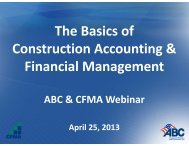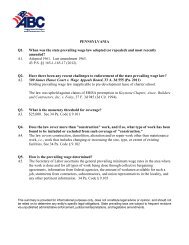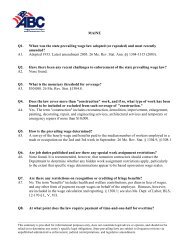PowerPoint Presentation (PDF) - Associated Builders and Contractors
PowerPoint Presentation (PDF) - Associated Builders and Contractors
PowerPoint Presentation (PDF) - Associated Builders and Contractors
Create successful ePaper yourself
Turn your PDF publications into a flip-book with our unique Google optimized e-Paper software.
SMALL AND EMERGING CONTRACTORSWEBINAR SERIES:BANKING AND FINANCING FORCONTRACTORSPresented by: Jason Bakke, CPA, CCIFP, PartnerCliftonLarsonAllen LLP
Webinar Objectives• Provide <strong>and</strong> overview of the commonly available lending optionsfor capital equipment financing <strong>and</strong> working capital needs ofcontractors• Review budgeting <strong>and</strong> management of cash flows• Discuss the factors that banks <strong>and</strong> other credit providerscommonly use to evaluate a small business for underwriting <strong>and</strong>lending purposes• Provide suggestions on successfully managing the bankingrelationship• Review best practices for cash‐related processes <strong>and</strong> controls
OVERVIEW –LOAN TYPES AND• Long‐Term Loans– Equipment / vehicle notes– Mortgages– Capital equipment line of creditCONSIDERATIONS• Operating / Working Capital Lines of Credit– Evaluation of needs ‐ borrowing capacity– Terms <strong>and</strong> rates• Small Business Administration (SBA) Loan Programs• Security, Terms <strong>and</strong> Rates
Purchase vs. LeaseEQUIPMENT LEASING:Advantages:• Minimal initial expenditure<strong>and</strong> impact on cash flow• Easier to obtain• Flexible terms <strong>and</strong> conditions• Balance sheet impact / ratiosDisadvantages• Higher overall cost• Lack of ownershipEQUIPMENT PURCHASEAdvantages:• Ownership• Tax incentives – Section 179or Bonus DepreciationDisadvantages• Ownership –risk ofobsolescence or utilization• Impact on cash flows <strong>and</strong>borrowing capacitySuggestion: Have a defined <strong>and</strong> processin place to evaluate whether purchase <strong>and</strong>financing is appropriate
Equipment FinancingEquipment <strong>and</strong> Vehicle Notes:• Common Terms:– Generally 3 to 5 years; fixed monthly payment– Interest at fixed rates based upon market <strong>and</strong> credit considerations– Security:• Specifically identified equipment• Personal guarantee from the corporation / related businesses / owners?– Covenants
Equipment FinancingEquipment Financing Considerations:• Equipment consolidation loans:– Reduced interest rates– Increased terms; improved cash flow implications– Increased flexibility – interest‐only periods– Increased collateral –blanket security agreement; personal guaranteesprobable• Equipment Acquisition Line of Credit:– Fixed line to provide for multiple planned purchases over a period of time– Interest initially at variable rate; converts to fixed, amortized loan atmaturity• SBA Loans
Lines of Credit ‐ OperatingOperating / Working Capital Lines of Credit• Used to finance the day‐to‐day operations of the business– Purchase materials or inventory– Pay operating costs –labor, fringes, subcontracts, overhead, etc.• Security:– Accounts receivable– All business assets– Personal guarantees from owners / management / related parties• Terms & Considerations– Interest – generally variable rate (Prime Rate, LIBOR, etc)– Interest rate floors– Commitment fee – unused capacity– Covenants
Lines of Credit ‐ OperatingCritical Questions:How much short‐term borrowing capacity do I need?How do I secure the necessary financing capacity?
CASH FLOW BUDGETINGAND MANAGEMENT
Lines of Credit ‐ OperatingCash Flow Projections & Budgeting –not an event; a process• Every business must utilize cash flow projections as a key tool tomanage their operations <strong>and</strong> evaluate their financing needs• Be thorough <strong>and</strong> realistic• Monitor <strong>and</strong> revise cash flow assumptions:– Revenue <strong>and</strong> billings– Collections on AR <strong>and</strong> retentions– Timing of payments to vendors, employees, subs– Fixed costs <strong>and</strong> overhead– Taxes <strong>and</strong> distributions
ILLUSTRATION –CASH FLOW PROJECTION
CASH FLOW PROJECTION ‐ ASSUMPTIONSCollections Assumptions:Existing A/R Future BillingsCurrent Month 25% 0%30-days 25% 60%60-days 25% 25%90-days 25% 10%120-days 0% 5%Retentions 180 180 DaysGross Profit / Vendor Payment AssumptionsCosts of Sales % of Sales Current 30 Days 60 DaysLabor & Fringe 28% 100%Materials 27% 0% 75% 25%Subcontractors 18% 0% 25% 75%Equipment - Various 7% 0% 75% 25%Other 8% 0% 75% 25%Gross Profit: 12%
CASH FLOW PROJECTION ‐ ACTIVITYCurrent Accounts Receivable - December 31, 2012January February March April May June TOTALContract Billings 360,000 - - - - - 360,000Retention 40,000 - - - - - 40,000Total Billings 400,000 - - - - - 400,000Cash Flows - Current Receivables: - - - - - - -Cash Flows - Future Billings & Retention: - 144,000 126,000 54,000 36,000 40,000 400,000Total Cash Flows - In: - 144,000 126,000 54,000 36,000 40,000 400,000Costs of SalesLabor 112,000 - - - - - 112,000Materials - 81,000 27,000 - - - 108,000Subcontractors - 18,000 54,000 - - - 72,000Equipment - Various - 21,000 7,000 - - - 28,000Other - 24,000 8,000 - - - 32,000Total: 112,000 144,000 96,000 - - - 352,000
Current Accounts Receivable 400,000 December 31, 2012January February March April May June TOTALContract Billings 360,000 1,080,000 3,150,000 1,980,000 1,080,000 450,000 8,100,000Retention 40,000 120,000 350,000 220,000 120,000 50,000 900,000Total Billings 400,000 1,200,000 3,500,000 2,200,000 1,200,000 500,000 9,000,000Cash Flows - Current Receivables: 100,000 100,000 100,000 100,000 - - 400,000Cash Flows - Future Billings & Retention: - 216,000 738,000 2,196,000 2,101,500 1,552,000 6,803,500Total Cash Flows - In: 100,000 316,000 838,000 2,296,000 2,101,500 1,552,000 7,203,500Costs of SalesLabor 112,000 336,000 980,000 616,000 336,000 140,000 2,520,000Materials - 81,000 270,000 789,750 681,750 391,500 2,214,000Subcontractors - 18,000 108,000 319,500 571,500 351,000 1,368,000Equipment - Various - 21,000 70,000 204,750 176,750 101,500 574,000Other - 24,000 80,000 234,000 202,000 116,000 656,000Total: 112,000 480,000 1,508,000 2,164,000 1,968,000 1,100,000 7,332,000General & AdministrativePayroll 8,500 12,500 16,000 16,000 16,000 12,500 81,500Benefits 3,400 5,000 6,400 6,400 6,400 5,000 32,600Rent 7,000 7,000 7,000 7,000 7,000 7,000 42,000Utilities 750 750 750 750 750 750 4,500Insurance 1,200 1,200 1,200 1,200 1,200 1,200 7,200Miscellaneous 1,000 1,000 1,000 1,000 1,000 1,000 6,000Total: 21,850 27,450 32,350 32,350 32,350 27,450 173,800Cash Flows from Operations: (33,850) (191,450) (702,350) 99,650 101,150 424,550 (302,300)Debt ServicePrincipal & Interest - Term Debt (12,000) (12,000) (12,000) (12,000) (12,000) (12,000) (72,000)Interest - Line of Credit - Average Balance - (146) (1,571) (6,583) (6,015) (5,433) (19,748)NET CASH FLOWS: (45,850) (203,596) (715,921) 81,067 83,135 407,117 (394,048)LOC SUMMARY:Cash / LOC Advances - Beginning 25,000 (20,850) (224,446) (940,367) (859,300) (776,165)Cash / LOC Advances - Ending (20,850) (224,446) (940,367) (859,300) (776,165) (369,048)
CASH FLOW PROJECTION ‐ ASSUMPTIONSCollections Assumptions:Existing A/R Future BillingsCurrent Month 25% 0%30-days 25% 40%60-days 25% 35%90-days 25% 15%120-days 0% 10%Retentions 180 180 DaysGross Profit / Vendor Payment AssumptionsCosts of Sales % of Sales Current 30 Days 60 DaysLabor & Fringe 28% 100%Materials 27% 0% 75% 25%Subcontractors 18% 0% 25% 75%Equipment - Various 7% 0% 75% 25%Other 8% 0% 75% 25%Gross Profit: 12%
Current Accounts Receivable 400,000 December 31, 2011January February March April May June TOTALContract Billings 360,000 1,080,000 3,150,000 1,980,000 1,080,000 450,000 8,100,000Retention 40,000 120,000 350,000 220,000 120,000 50,000 900,000Total Billings 400,000 1,200,000 3,500,000 2,200,000 1,200,000 500,000 9,000,000Cash Flows - Current Receivables: 100,000 100,000 100,000 100,000 - - 400,000Cash Flows - Future Billings & Retention: - 144,000 558,000 1,692,000 2,092,500 1,745,500 6,232,000Total Cash Flows - In: 100,000 244,000 658,000 1,792,000 2,092,500 1,745,500 6,632,000Costs of SalesLabor 112,000 336,000 980,000 616,000 336,000 140,000 2,520,000Materials - 81,000 270,000 789,750 681,750 391,500 2,214,000Subcontractors - 18,000 108,000 319,500 571,500 351,000 1,368,000Equipment - Various - 21,000 70,000 204,750 176,750 101,500 574,000Other - 24,000 80,000 234,000 202,000 116,000 656,000Total: 112,000 480,000 1,508,000 2,164,000 1,968,000 1,100,000 7,332,000General & AdministrativePayroll 8,500 12,500 16,000 16,000 16,000 12,500 81,500Benefits 3,400 5,000 6,400 6,400 6,400 5,000 32,600Rent 7,000 7,000 7,000 7,000 7,000 7,000 42,000Utilities 750 750 750 750 750 750 4,500Insurance 1,200 1,200 1,200 1,200 1,200 1,200 7,200Miscellaneous 1,000 1,000 1,000 1,000 1,000 1,000 6,000Total: 21,850 27,450 32,350 32,350 32,350 27,450 173,800Cash Flows from Operations: (33,850) (263,450) (882,350) (404,350) 92,150 618,050 (873,800)Debt ServicePrincipal & Interest - Term Debt (12,000) (12,000) (12,000) (12,000) (12,000) (12,000) (72,000)Interest - Line of Credit - Average Balance - (146) (2,075) (8,350) (11,323) (10,841) (32,735)NET CASH FLOWS: (45,850) (275,596) (896,425) (424,700) 68,827 595,209 (978,535)LOC SUMMARY:Cash / LOC Advances - Beginning 25,000 (20,850) (296,446) (1,192,871) (1,617,571) (1,548,744)Cash / LOC Advances - Ending (20,850) (296,446) (1,192,871) (1,617,571) (1,548,744) (953,535)
CASH IS KING:CASH FLOW MANAGEMENTJob Profitability• Bidding / estimating – project scope• Underst<strong>and</strong>ing true burdened costsCustomer Billing Practices• Customer credit• Commitment to timely <strong>and</strong> accurate billing practices• Core expectation of operations personnel• Underst<strong>and</strong> contract provisions <strong>and</strong> billing requirements• Opportunities to pre bill / overbillings• Timely close‐out / punch‐list
CASH IS KING:CASH FLOW MANAGEMENTChange Order Management – get paid for the work you do!• Documentation is critical to timely payment• Know owner’s requirements for approval <strong>and</strong> processing of extras• Timely billing –the longer you wait, the less likely you are to collectDiligent Collection Practices• The squeaky wheel gets the grease• Retain leverage: Monitor lien rights; timely documentation <strong>and</strong>filing• Retention balances –don’t let these fall under the radar
CASH IS KING:CASH FLOW MANAGEMENTEquipment / purchases / maintenance <strong>and</strong> repair• Rent vs. purchase• Evaluate financing <strong>and</strong>/or rental terms to minimize cash flowrequirements• Timing of new purchases, maintenance <strong>and</strong> non‐essential repairs• Monitor utilization of equipment; evaluate past decisionsPurchases <strong>and</strong> Vendor management• “Lean” management of material purchases, supplies <strong>and</strong> tools• Evaluate <strong>and</strong> negotiate payment terms with suppliers <strong>and</strong> vendors• “Pay when paid” clauses <strong>and</strong> practices• Subcontractor quality
CASH IS KING:CASH FLOW MANAGEMENTTax Planning / Accounting Methods• Tax planning• Accelerated depreciation methods• Accounting Method Selection:– Accrual versus cash basis of accounting– Contract methods: % of completion; completed contract; accrual‐lessretention– other• Underst<strong>and</strong> <strong>and</strong> anticipate “Deferred” income taxes / timingdifferencesDistributions <strong>and</strong> Capital
Small Business Administration (SBA)Guarantees <strong>and</strong> Loans
SBA Loans ‐ OverviewVariety of loan programs:• Working capital / Cap‐ex / Refinance –7(A) Program• Building / Equipment – 504 LoanShared Risk:• Small Business Administration provides a guarantee to the lender fora portion; government assumes the risk of default• Loans are achievable in circumstances where conventional financingis not possible.SBA approved lenders –many traditional lenders
SBA Loans ‐ OverviewAdvantages:• Less down payment or equity needed• Longer amortizations –10 to 25 years; 7 for working capital• Flexibility• Less continuing documentation <strong>and</strong> fewer covenantsDrawbacks:• Cumbersome application process• Costs –guarantee fee / servicing fee• Limitations – qualifications <strong>and</strong> capacities• Highly collateralized
LENDING EVALUATION PROCESS:Demonstrating yourCreditworthiness to a LenderThe 5 “C”’s for Lending Evaluation:• Capacity / Cash Flows• Collateral• Capital• Conditions• Character
CAPACITYCapacity represents the businesses ability torepay the loan.Underwriting Considerations:• Best evidence: Historical profitability <strong>and</strong> cash flows;Significant working capital <strong>and</strong> liquidity• Strength of your business plan; convince the bank to invest in youroperation• Prepare detailed budgets <strong>and</strong> forecasts; be prepared to discuss howyou are going to achieve the results• Cash flow projections –how <strong>and</strong> when will the lender get paid?• Business practices – marketing, cash flow management <strong>and</strong> expensemanagement
Financial Analysis & Benchmarking –How do you stack up?Key Ratios – Liquidity –your company’s ability to satisfy short‐termobligations:• Working capital = total current assets –total current liabilities• Current ratio = current assets / current liabilitiesKey Ratios –Leverage –how much does your company rely on debt<strong>and</strong> financing?:• Debt to equity ratio: total liabilities / total equity• Tangible net worth = total equity
Financial Analysis & Benchmarking –How do you stack up?Key Metrics <strong>and</strong> Ratios – Efficiency –how well do you manage yourbusiness practices?• Accounts receivable aging• Days sales in accounts receivable• Over/under billings• Gross profit / profit‐fade on estimatesKey Metrics –Cash Flow• EBITDA –Net Income + interest + taxes + depreciation &amortization• Coverage ratios ‐ various
Financial Analysis & Benchmarking –How do you stack up?Take Away – You should underst<strong>and</strong> the criteria that banks <strong>and</strong>underwriters are using to evaluate your creditworthiness;proactively manage the results whenever possibleConsiderations:• Importance of quality <strong>and</strong> timely financial information• Benchmark your company against others in the industry• Structure financing <strong>and</strong> lease agreements to maximize workingcapital <strong>and</strong> liquidity• Retain capital ‐ manage distributions, tax methods• Consult regularly with your CPA, banker <strong>and</strong> other advisors
COLLATERAL & SECURITYCollateral has a direct correlation to capacity.Provides security to the lenderExamples:• Pledge business assets – equipment, receivables, inventory, lifeinsurance, etc• Mortgage• Personal or non‐business assets• Guarantees – personal or related‐party business
COLLATERAL & SECURITYCommonly Discounted or Disregarded Assets:• Receivables/advances from owners or related parties• Non‐current receivables – 60/90+ days outst<strong>and</strong>ing• Bonded receivables• Underbillings• IntangiblesEquipment Valuation – Maximizing Borrowing Capacity:• Equipment – lives <strong>and</strong> methods; salvage value• Consider desktop appraisal• Lender philosophy
CAPITALCapital represents the owner’s investment in thebusinessOwners must have significant personal <strong>and</strong> financial investment in thebusiness before a lender will consider a business loanExamples:• Net worth <strong>and</strong> Equity• Subordinated loans to the company
ConditionsEconomic <strong>and</strong> industry considerations• Overall economic climate• Factors influencing the company’s industry (competition, outlook)• The company’s reputation <strong>and</strong> customer relationships• Factors influencing the bank; industry exposure & regulatoryLoan Terms <strong>and</strong> Conditions• Purpose of the loan – expansion, refinance, working capital, etc.• Credit history of the company <strong>and</strong> guarantors• Relevant terms of the loan
CharacterTrustworthiness: Aside from capacity, character could be themost important factor influencing lending decisions <strong>and</strong>underwriting• Highly subjective judgment made about you <strong>and</strong> your company• Character <strong>and</strong> reputation are earned over time– Difficult to earn <strong>and</strong> easy to loose• Can be effectively managed ‐ focus of the “banking relationship “section
Banking Relationship
Banking RelationshipChoosing the “Right Bank”• Assessment of products, services <strong>and</strong> capacity• Character <strong>and</strong> trust• Construction industry experience– Underst<strong>and</strong>s your business <strong>and</strong> the unique challenges <strong>and</strong> considerations ofthe industry– Active in trade events <strong>and</strong> industry associations– Referrals from trusted advisors, peers <strong>and</strong> others in the industry• Customer service <strong>and</strong> convenience
Building <strong>and</strong> Maintaining the RelationshipTreat lender as a business partner, not an adversaryOpen <strong>and</strong> effective communication– Maintain <strong>and</strong> provide quality, timely <strong>and</strong> accurate financial information– Regular meetings with your lender; include other advisors when possible– No surprises!– Be conservative – exceed projections vs. explaining why forecasts were notachievedDiscuss significant business decisions with your lender early‐onProvide required information timely <strong>and</strong> accurately
DEPOSIT ACCOUNTSOverview of cash controls <strong>and</strong>considerations
Internal Controls ‐ CashA properly designed system of internal control will ensure that no singleindividual would have control over two or more phases of asignificant transaction or operation.Benefits:• deliberate fraud is more difficult because it requires collusion of twoor more persons• it is much more likely that innocent errors will be found <strong>and</strong>corrected in the ordinary course of business.Challenge: Limited personnel = concentration of responsibility
QuestionsContact Informationwww.cliftonlarsonallen.comJason C. Bakke, CPA, CCIFPPartner –Construction & Real EstateCliftonLarsonAllen LLPJason.Bakke@cliftonlarsonallen.com612‐376‐4638www.facebook.com/cliftonlarsonallenwww.linkedin.com/company/CliftonLarsonAllen40












